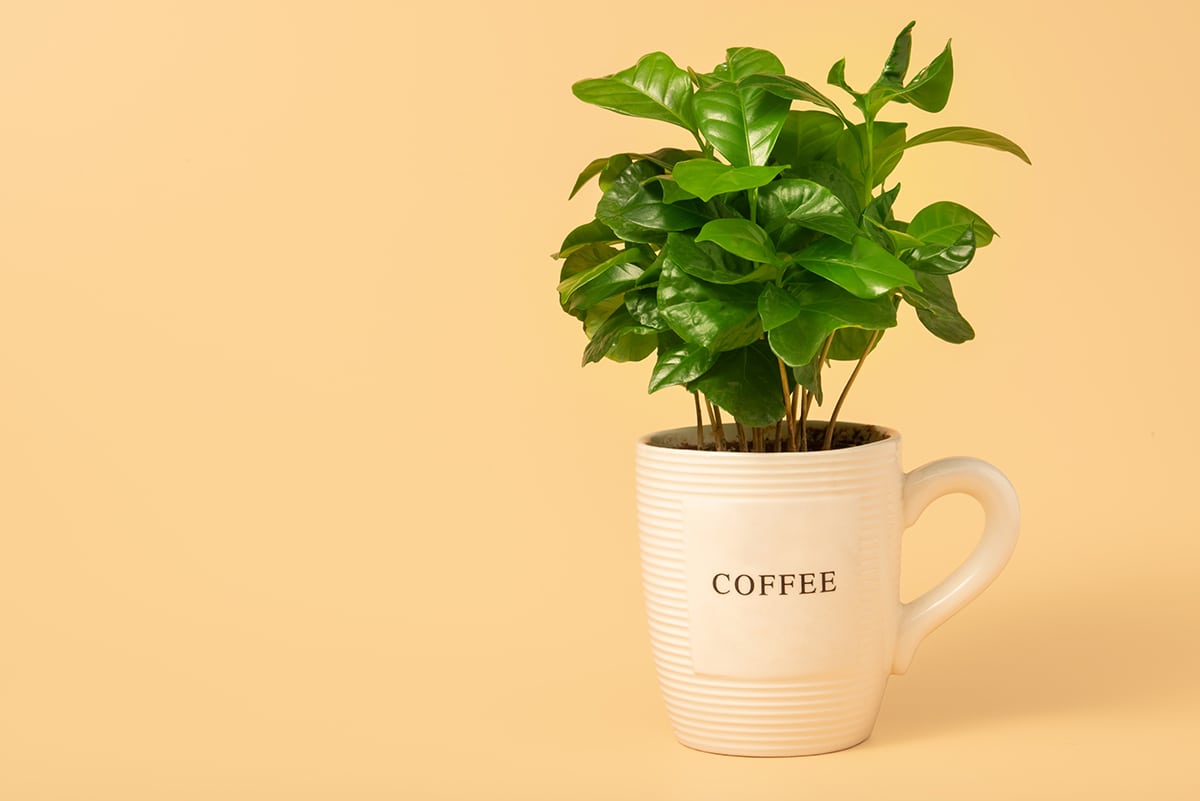Growing a coffee plant indoors might sound like a gardener’s dream, but it’s surprisingly attainable. With just a few strategic steps, you can nurture your own coffee plant from the comfort of your living room, enjoying the lush greenery and the thrill of eventually harvesting your own beans. Here’s how to turn your indoor space into a mini coffee plantation.
| Common Name | Coffee Plant |
| Botanical Name | Coffea arabica |
| Family | Rubiaceae |
| History & Origin | Native to tropical Africa |
| Plant Type | Evergreen shrub |
| Mature Size | Up to 6 feet indoors |
| Sun Exposure | Bright, indirect light |
| Soil Type | Well-draining, peaty |
| Soil pH | Slightly acidic |
| Temperature | Prefers 60-75°F (15-24°C) |
| Watering | Keep soil moist, but not waterlogged |
| Fertilizing | Monthly during growing season; less in winter |
| Toxicity | Generally safe for pets and humans |
Table of Contents
Light
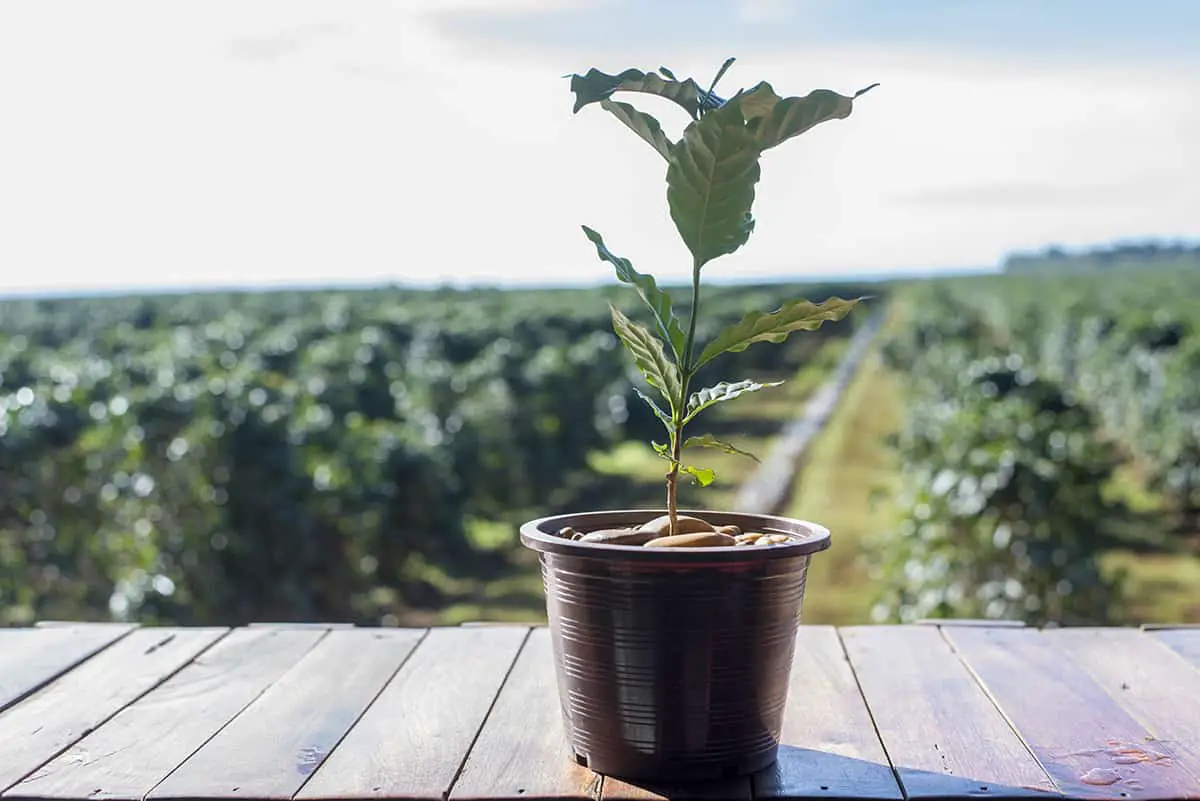
Growing a coffee plant indoors requires giving it the right amount of light. Place your coffee plant near a bright window with medium to high light levels for the best results. Ideally aim for 14-20 moles per square meter per day of light. Make sure the plant receives at least 6 hours of indirect sunlight daily.
Rotate your plant every few weeks to ensure all parts get equal exposure to light. This helps promote even growth and minimize stretching or leaning of the plant. However, you should avoid exposing your coffee plant to direct sunlight, as it can cause scorching or leaf damage.
In places with insufficient natural light, consider using artificial light sources. Choose an appropriate fixture, such as LED or fluorescent, that can provide a target Daily Light Integral (DLI) to encourage healthy growth. Make sure to adjust the distance between the light source and the plant, as mentioned in the supplemental light setup recommendations.
Remember to monitor your coffee plant’s growth and appearance. Signs of sufficient light include vibrant green leaves and sturdy stems. Adjust the light intake if you notice pale, leggy, or drooping growth, as these can indicate a lack of light.
Soil
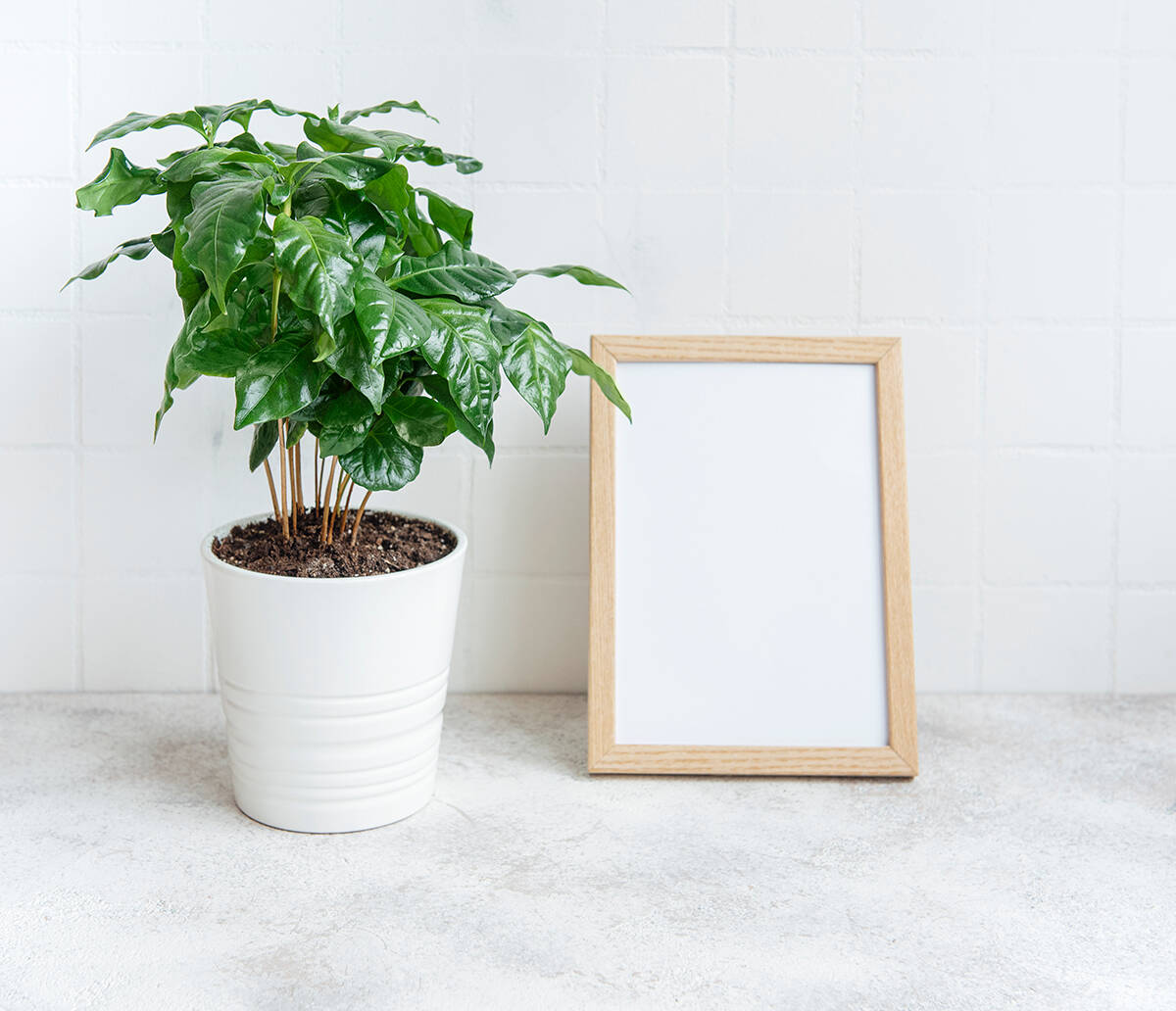
To grow a coffee plant indoors, begin by selecting a well-draining organically rich soil. This type of soil promotes healthy root growth, ensuring your coffee plant thrives. Ensure that your container has drainage holes to prevent waterlogging, as excessive moisture can harm the plant.
Next, create a mound of native soil that is two to three feet high and four to ten feet in diameter. Dig a hole in the mound, approximately three to four times the diameter, and three times as deep as your plant’s container. Plant your coffee seedling and fill in the hole with the remaining soil mixture. Remember to press the soil firmly around the plant’s base, securing it in the container.
Regularly water your coffee plant, maintaining an evenly moist, but not soggy, soil. Overwatering can cause root rot while underwatering might lead to unhealthy growth. Place your potted coffee plant in a location with bright, indirect light, ideally an eastern or southern exposure.
Lastly, apply mulch to your coffee plant’s soil surface. This added layer helps conserve moisture, reduce weed problems, and improve soil quality. Use a 2- to 6-inch layer of bark, wood chips, or similar mulching materials, keeping it 8 to 12 inches from the trunk to avoid trunk rot issues.
Water
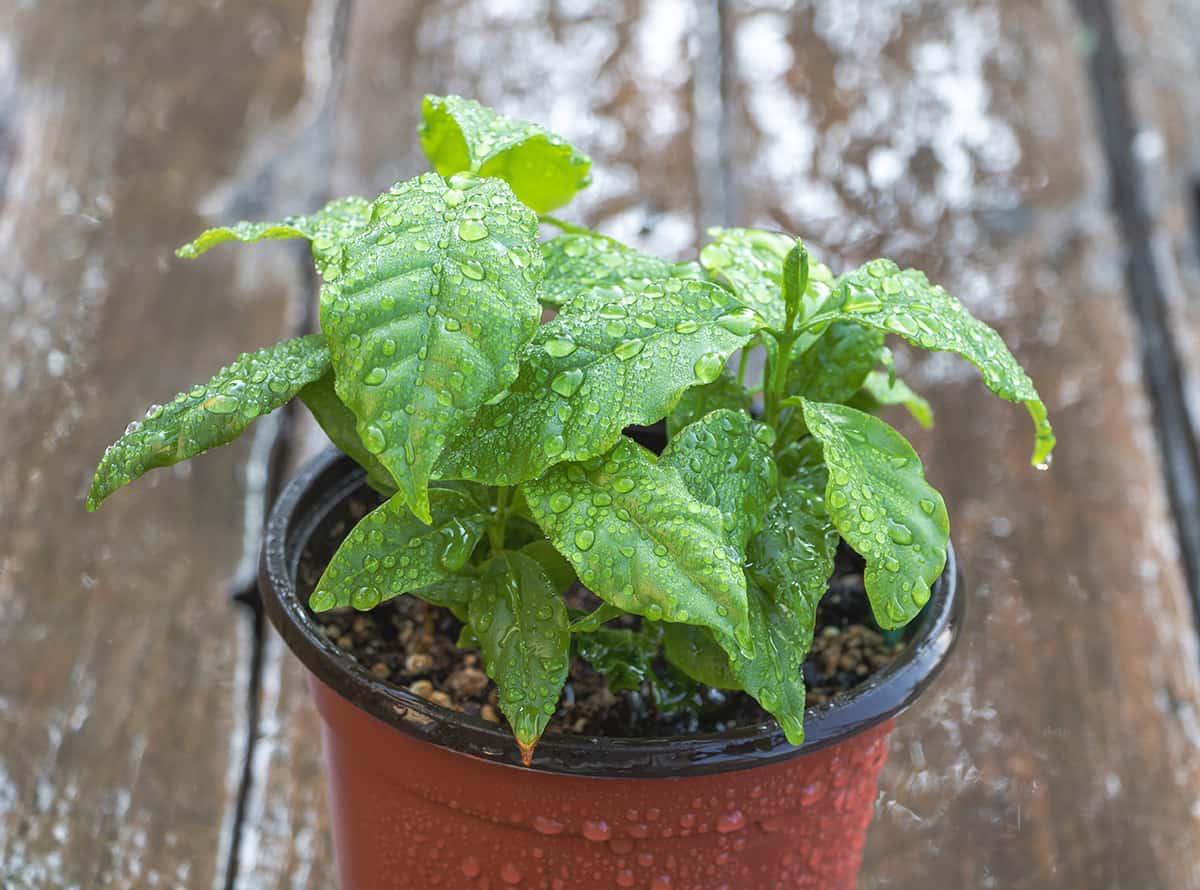
When growing a coffee plant indoors, it is crucial to strike the right balance in watering. Coffee plants prefer well-drained soil. However, they also need consistent moisture. In general, you should water your coffee plant when the top layer of soil appears less than half wet.
At the beginning, you might wonder how much water to provide, but don’t worry. Test by inserting your finger into the soil up to your first knuckle. If it feels dry, it’s the right time to water your plant.
Keep in mind that over-watering can cause root rot, so it’s better to err on the side of caution. Underwatering, on the other hand, can lead to slow growth and spindly, weak stems. Maintaining balance is key to attaining a thriving coffee plant.
As a rule of thumb, try to water your coffee plant thoroughly, allowing the water to drain out. This way, you’ll ensure the roots receive ample hydration without drowning them. Additionally, consider using a pot with drainage holes and a saucer to catch excess water. The right amount of water will encourage healthy, robust growth and support those thick, lush leaves.
Temperature and Humidity
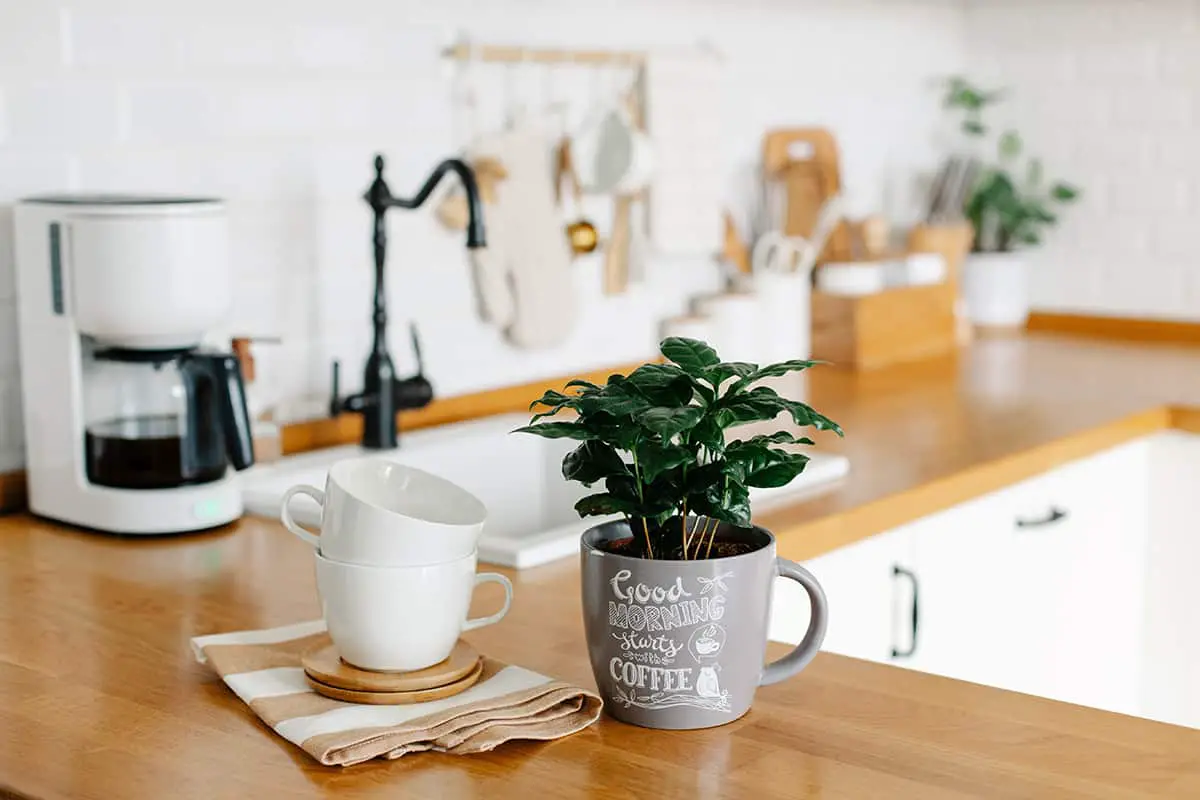
When growing a coffee plant indoors, managing temperature and humidity is very important. Your coffee plant prefers daytime temperatures between 70° and 80°F, and nighttime temperatures between 60° and 68°F. Be cautious of extreme fluctuations as they can harm your plant.
The optimal humidity for your indoor coffee plant should be relatively high, ideally around 60-70%. If you live in a dry climate, consider using a humidifier to maintain the desired level. Also, placing your plant on a tray filled with pebbles and water can help increase humidity around it. Be aware that inadequate humidity can lead to brown leaf edges.
When it comes to location, avoid placing your coffee plant near heating or cooling vents, as these can greatly affect both temperature and humidity. Choose a location that provides bright, indirect light, as strong, direct sunlight can cause leaf scorching.
Fertilizer
Choose a mild balanced fertilizer that won’t overwhelm your plant. Apply it monthly during the growing season to promote healthy growth.
You don’t need large amounts of fertilizer for most indoor plants. The goal is to compensate for leaf loss and not to encourage rapid growth of large plants. Opt for liquid, granular, or tablet forms of fertilizers based on your preference and convenience.
For optimal results, use a 10-10-10 fertilizer with minor elements. Mix ¼ ounce of this liquid fertilizer per gallon of water and apply it every six weeks during the growing season.
Propagation
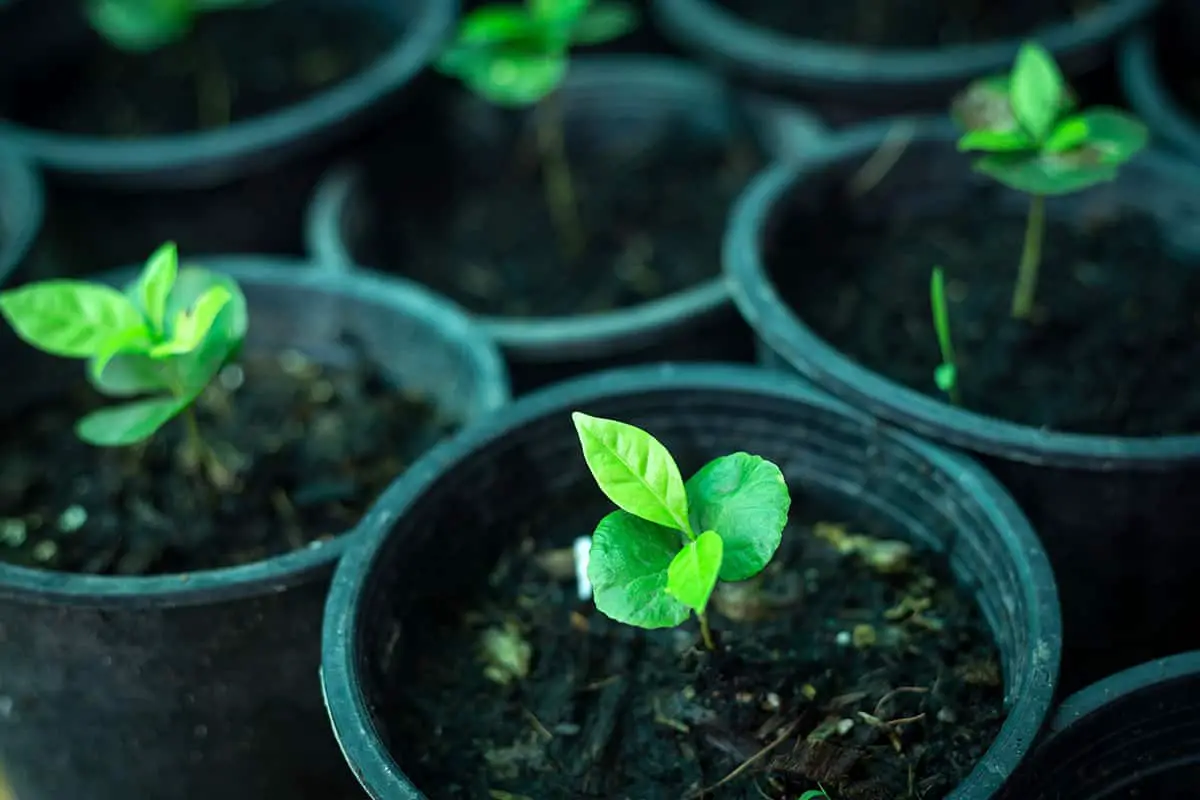
When propagating your coffee plant, it’s essential to choose healthy stem tip cuttings. Begin by selecting a stem tip with 2 to 3 leaves, ideally around 4-6 inches long. Make a cut below a leaf node, as this is where the roots will develop. To improve the success rate, dip the cutting in rooting hormone.
Once you have prepared the cutting, plant it in well-draining soil, such as a mix of perlite and peat moss. Ensure the pot has drainage holes to prevent waterlogging. Place your cutting in a warm, bright area with indirect sunlight to encourage root growth.
To maintain high humidity levels, cover the cutting with a plastic dome or bag. Monitor the cutting frequently, and adjust the light, humidity, or temperature as needed.
After 3 to 6 weeks, your cutting should develop roots. Gently tug on the cutting to check for resistance, which indicates root growth. Once your cutting has established roots, remove the plastic dome or bag, and continue to care for the plant in its optimal growing conditions. Provide temperatures between 59 to 75°F (15-24°C), high humidity, and protection from direct sunlight and wind.
Pruning
Pruning is an essential aspect of growing a coffee plant indoors. Proper pruning helps maintain a manageable size for your plant and promotes higher yields. Let’s dive into the basics of pruning your indoor coffee plant.
To start, it is crucial to prune coffee plants after they bloom. This practice encourages new growth and higher fruit production for the following year. Keep an eye on your coffee plant and make sure the blossoms have fallen off before beginning the pruning process. University of Florida recommends pruning plants periodically to limit their height so that they can be easily maintained in an indoor environment.
While pruning, focus on removing weak, crossed, or diseased branches. This step ensures healthy growth and reduces the chance of pests or diseases spreading throughout the plant. Use clean, sharp pruning shears to make clean cuts on the branches. Be careful not to remove more than one-third of the plant’s foliage during a single pruning session.
It is also essential to shape your coffee plant as it grows. Prune your plant to maintain a compact, bushy form that can thrive indoors. Keep in mind that wild coffee plants can grow up to 10-12 feet high, but with proper pruning, you can keep your plant much smaller and suitable for an indoor setting.
Potting and Repotting

To start growing a coffee plant indoors, choose a well-draining pot with a shard over its drainage hole. This technique helps prevent soil leakage. Avoid filling the pot’s bottom with gravel, as it can cause drainage issues. Place enough new potting mix in the pot to raise the root ball, leaving an inch or two below the rim for watering.
Regular repotting promotes new growth in your coffee plant. The ideal time for repotting is late winter, just as the natural light level increases and plants transition out of their winter dormancy. Remember, most plants grow as large as their root system allows, so a larger pot can lead to increased root mass and a bigger plant.
Common Problems & Troubleshooting
When growing a coffee plant indoors, you may encounter some issues that require attention.
Discoloration and stunted leaves: An off-color may signal a nutrient issue, insect damage, or possibly too much or too little water. Small, misshapen leaves also point to pest or nutrient problems, or improper care. To address these issues, ensure your plant gets proper nutrients, adequate water, and inspect for pests. Maintain a consistent care routine to avoid future problems.
Pest issues: Several indoor insects and pests may harm your coffee plant. Common insects like fungus gnats often thrive when potting soil is rich in organic matter or when overwatering occurs. Keep the soil moist but not soggy, and consider using a pesticide if infestations persist.
